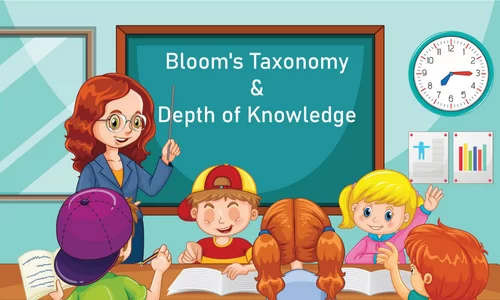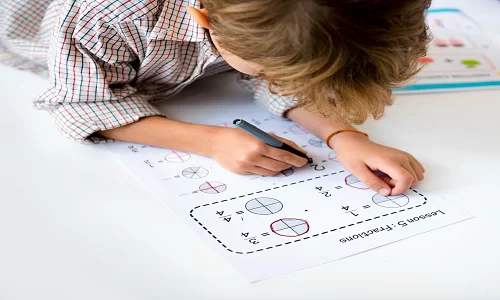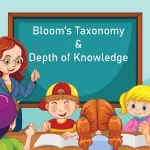One approach that has become increasingly popular over the years is using Bloom’s Taxonomy and Depth of Knowledge (DOK) to gauge student learning. Teachers can test students’ knowledge with multiple assessment tools and testing techniques.
Educators must use the most effective teaching pedagogies and types of assessments to help the students learn and succeed.
Comparison of Bloom’s Taxonomy and Depth of Knowledge.
Bloom’s Taxonomy and Depth of Knowledge are theories that guide ways to assess student learning. These are like standards that help teachers worldwide assess students on common parameters.
Bloom’s Taxonomy is a framework for categorizing educational goals and objectives based on their level of complexity and specificity. It was first introduced by Benjamin Bloom in 1956 and has since been updated and modified by other educators.
Bloom’s Taxonomy levels
There are six levels of bloom’s taxonomy
Level 1: Remember
Assessments in the remembering level are intended to check the student’s knowledge of the recently learned concepts and to know if they can recall what they have learned.
Level 2: Understand
Assessments in the second level of Bloom’s Taxonomy take recalling what was learned to the next level. It evaluates if the student can describe the learned concepts in more detail and in different ways.
Level 3: Apply
In the next level of Bloom’s Taxonomy, the teachers can gauge the students’ knowledge through their ability to practically apply it in real-life situations and solve problems using the concepts.
Level 4: Analyze
In the fourth level of Bloom’s Taxonomy, teachers can assess the student’s understanding of the various variables within the concept. The students are asked to analyze, classify and explain the relationship among the different parts of the learned concept.
Level 5: Evaluate
At the evaluation level, the assessment is based on the idea of understanding the students’ ability to make decisions and judgments based on the problems and situations of a learned concept. The student should be able to evaluate the lesson’s thoughts and uniquely critique their understanding.
Level 6: Create
In the last level of Bloom’s Taxonomy of learning , a student is assessed on the ability to create something new out of the learned concept. For example, a student can be asked to create a thesis statement or a new music composition, draw, organize, or produce a new piece of art.
Each level builds upon the previous one and represents a different level of thinking and cognitive complexity.
Levels in Depth of Knowledge
Depth of Knowledge, or DOK, is a framework that categorizes the complexity of cognitive processes that students must use to answer questions or complete tasks. DOK ranges from level 1, which requires simple recall of facts or information, to level 4, which requires students to engage in complex reasoning and analysis.
The four levels of Depth of Knowledge are:
Level 1: Recall
The first level assesses the student’s ability to recall information and lessons learned in classrooms.
Level 2: Skills and Concepts
In the second level of DOK, the teacher assesses the deeper understanding of the concept by asking them to answer various questions which use the knowledge of the learned concept. The students can be asked to do basic reasoning using the concept and compare the information.
Level 3: Strategic Thinking
In the third level of DOK, a student’s advanced skills of conceptual understanding are used to create situations, critical thinking, and problem-solving.
Level 4: Extended Thinking
In the extended thinking level, the student has the knowledge to use the concept to create a different idea, prove a situational impasse, critique the idea, and apply the concepts.
Concept: Webb, Norman L. and others. “Web Alignment Tool” 24 July 2005. Wisconsin Center of Educational Research. University of Wisconsin-Madison. 2 Feb. 2006.
Guidelines to use Bloom’s Taxonomy and Depth of Knowledge for creating Assessments
Using both Bloom’s Taxonomy and DOK together can help teachers create more effective lesson plans and assessments, as they can more accurately gauge the levels of thinking required of their students. For example, a level 1 question might ask students to recall a fact or definition, while a level 4 question might ask them to analyze, evaluate, and synthesize information from multiple sources.
Evelyn has created several assessment sheets and worksheets to help gauge student knowledge.
Evelyn developed the following worksheet, which is drafted so that teachers can check the memory of the lesson taught in the class. The questions in the worksheet are created to assess the remembering power of the students.
The Math worksheet below is an assessment that helps to gauge the student’s understanding of the concept. The stage from Bloom’s taxonomy concept is ‘understanding’; the worksheet is a level 1 question from the DOK’s concept.
Incorporating Bloom’s Taxonomy and Depth of Knowledge into Classroom Learning
One way to incorporate Bloom’s Taxonomy and DOK into classroom instruction is through learning objectives. Teachers can understand what a classroom wants and draft the learning objectives accordingly. These objectives can guide a teacher on how they want to pursue their lessons and how they would assess the students’ learning.
Learning objectives should be clear and specify the needs they are intended to meet. A well-written learning objective should be specific, measurable, achievable, relevant, and time-bound (SMART).
By incorporating Bloom’s Taxonomy and DOK into the learning objective, teachers can create goals targeting specific thinking and cognitive levels of complexity.
Assessment is another area where Bloom’s Taxonomy and DOK can be helpful. Teachers can use both frameworks to create assessments that measure students’ knowledge and understanding at different levels. This helps teachers identify areas where students may need additional instruction or support.
Another way to use Bloom’s Taxonomy and DOK in the classroom is through open-ended questions and tasks. Open-ended questions allow students to engage in higher-level thinking and can help them develop critical thinking skills. Similarly, open-ended tasks require students to use various cognitive processes to complete them successfully.
Conclusion
Incorporating Bloom’s Taxonomy and DOK into classroom instruction can help teachers create effective lesson plans and assessments and gauge student knowledge and understanding at different levels. Using both frameworks, teachers can ensure they provide their students with opportunities to engage in higher-level thinking and develop critical thinking skills. Ultimately, this can lead to better student academic outcomes and a more effective and rewarding teaching experience for educators.

















